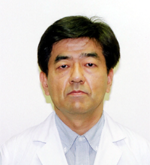Department of Dermatology
01Department Outline

Director
Toshio Otani
Our priority in this department is working towards the correct diagnosis of uncommon diseases. Generally, our inpatients have other generalized symptoms, but we also have patients with non-generalized symptoms who require detailed diagnostic testing. Outside of the wards, we have outpatients coming to us whose symptoms are not yet stable.
Our main admissions include: bacterial infection, viral infection, malignant tumor, drug-induced rash, autoimmune bullous dermatosis, connective tissue disease/vasculitis, vascular insufficiency, inflammatory keratosis, hives, erythema, and eczema/dermatitis.
02Conditions handled in this department
Eczema, dermatitis
Patch testing to reveal allergens for contact dermatitis.
Investigating allergens and the clinical condition of atopic dermatitis.
Inform patients on necessary everyday precautions and prescription use.
Hives
Investigation of allergens through blood and other testing.
Determining the presence of infectious disease or underlying disease.
Inform patients on necessary everyday precautions and prescription use.
Erythema
Testing to determine the causes of Stevens-Johnson syndrome, erythema nodosum and erythema annulare.
Inpatient treatment for Behçet’s disease, Sweet’s disease and adult onset Still’s disease.
Vasculitis
Confirming diagnosis with skin biopsy and blood testing.
Investigation of possible complications.
Inpatient treatment.
Vascular insufficiency
Testing for livedo reticularis and Raynaud phenomenon.
Topical treatment for leg ulcer.
Drug eruption
Evaluation of severity through skin biopsy and blood testing.
Investigation of cause using blood testing, patch testing and readministration/elimination.
Bullous disease, pustulosis
Confirmation of diagnosis by skin biopsy and blood testing.
Inpatient treatment for autoimmune bullous disease.
Investigation for the cause of palmoplantar pustulosis.
Inflamed keratosis
Determining the severity of psoriasis, and treatment with biologics in severe cases.
Investigation of the cause of lichen planus.
Inform patients on necessary everyday precautions and prescription use.
Skin tumour
Confirmation of diagnosis by dermatoscopy and skin biopsy.
Chemotherapy for malignant skin tumors, including melanoma.
Diseases of the skin appendages (acne vulgaris, rosacea, alopecia)
Cryotherapy, topical immunotherapy and other treatments for alopecia areata.
Oral therapy for male pattern baldness.
Inform patients on necessary everyday precautions and prescription use.
Connective tissue disease
Confirmation of diagnosis by skin biopsy and blood testing.
Admission for acute-stage systemic lupus erythematosus, scleroderma and dermatomyositis.
Infectious diseases
Identification of pathogenic microorganisms by microscopic and culture analysis, and blood testing.
Admission for erysipelas, cellulitis and respective viral infections.
03Accreditations
Accredited training facility: Japanese Dermatological Association



